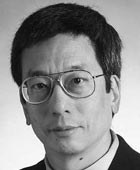Roger Y. Tsien has been awarded the Dr H.P. Heineken Prize for Biochemistry and Biophysics 2002 for his extraordinary and unique contribution to the development of a series of methods and techniques for measuring and visualising processes within and between cells.
Roger Tsien can attribute his greatest claim to fame in the scientific world to Aequorea victoria, a jellyfish which glows brightly in the dark. It does this this with the help of the ‘green fluorescent protein’ (GFP) molecule, which Tsien has been a leader in improving and exploiting. His laboratory has even managed to create mutants with other colours. Introducing GFP or its variants into a cell makes it possible to follow all kinds of biochemical processes within living cells ‘in real time’: they are literally made visible. Tsien’s molecules can be used to track the transmission of signals between cells, monitor intracellular acidity and follow the movement of sodium and calcium within cells. Measurements in cell organelles are now also possible using GFP. Tsien’s methods are widely used by researchers for other purposes, including searching for the factors involved in the creation of malignant cells. Tsien himself is responsible inter alia for laying bare a molecular mechanism involved in the synaptic adaptive capacity of the brain.
Further reading
The Green Fluorescent Protein. Annual Review of Biochemistry 67 (1998) 507-544.
Griffin, B.A., Adams S.R. and Tsien R.Y., Specific Covalent labeling of Recombinant Protein Molecules Inside Live Cells. Science 281 (1998), 269.
Baird G.S., Zacharias D.A. and Tsien R.Y., Biochemistry, mutagenesis, and oligomerization of dsRed, a red fluorescent protein from coral. Proc.Natl.Acad.Sci. 97 (2000) 11984-11989.
Zacharias D.A., Baird G.S. and Tsien R.Y., Recent advances in technology for measuring and manipulating cell signals. Current Opinion in Neurobiology 10 (2000) 416-421.
Honda A., Adams S.R., Sawyer C.L., Lev-Ram V., Dostmann W.R.G. and Tsien R.Y., Spatiotemporal dynamics of guanosine 3′,5′-cyclic monophosphate revealed by a genetically encoded, fluorescent indicator. Proc.Natl.Acad.Sci.USA 98 (2001) 2437.
Biography
Roger Y. Tsien was born in New York in 1952. He studied chemistry and physics at Harvard College, graduating summa cum laude in 1972, following which he joined the Physiological Laboratory at Cambridge University in the UK with the aid of a Marshall scholarship. After obtaining his Ph.D. there in 1977, Tsien remained as a researcher in Cambridge until 1981. He then returned to America to take up a post at Berkeley, where he ultimately became a professor in the Physiology & Anatomy faculty. Since 1989 he has been attached to the University of California in San Diego, as Professor of Pharmacology and Professor of Chemistry and Biochemistry, and is also an investigator for the Howard Hughes Medical Institute. Tsien has been receiving prizes for his work since as far back as 1968, including the W. Alden Spencer Award in Neurobiology from Columbia University (1991) and the Pearse Prize from the Royal Microscopical Society (2000). In 2008 he won the Nobel Prize in Chemistry, together with Osamu Shimomura and Martin Chalfie. Since 1998 he has been a member of the National Academy of Sciences of the United States. Tsien died 24 August 2016.
